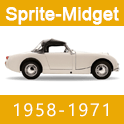
One of the greatest innovations in the design of the Classic Mini was its rubber cone suspension. The compact design and lasting quality of the rubber cone helped make the Mini what it is today: a beloved classic! Designed in the late 1950s, these cones were far ahead of their time. The only problem is that many of us are still driving around on the same cones cones that could have been built in the early '60's; the design is good, but not everlasting! With age, the rubber on these cones degrades, not only getting very hard, but it also sags and loses its ability to hold the car upright. It is not uncommon to have a cone sag so badly that it lowers the car 2-3", causing it to handle terribly! These cones should be replaced every 5-7 years depending on use and climate. Measured at the wheel, the spring rates at the static load position are 118 lb/in at the front and 98 lb/in at the rear. With three passengers and 50 lb of luggage, the loads per wheel at the same position are respectively 468 lb and 355 lb. These loads rise to 1,050 lb and 670 lb at full bump and fall to 240 lb and 100 lb when the rebound check is in operation. Early cones were SAE (UNF 1/2x20), all current cones now have metric threads (14mmX2).
See C-STR687 for stiffer road/rally version ("red dot"), or C-STR688 for race/competition version ("yellow dot").
To completely modernize your suspension from rubber to coil springs, see C-SRP100.
Be aware that the originals had standard threads in them and all of the new cones have metric threads if you use a spring compressor tool when removing and fitting.
Mini Mania Tech Team
The Classic Mini Parts and Accessories Experts
Here's the knuckle joint: https://www.minimania.com/part/21A1163/Classic-Mini-Cooper-Joint-knuckle-Assembly-Ball-Joint
Mini Mania Tech Team
The Classic Mini Parts and Accessories Experts
Mini Mania Tech Team
The Classic Mini Parts and Accessories Experts
One of the greatest innovations in the design of the Classic Mini was its rubber cone suspension. The compact design and lasting quality of the rubber cone helped make the Mini what it is today: a beloved classic! Designed in the late 1950s, these cones were far ahead of their time. The only problem is that many of us are still driving around on the same cones cones that could have been built in the early '60's; the design is good, but not everlasting! With age, the rubber on these cones degrades, not only getting very hard, but it also sags and loses its ability to hold the car upright. It is not uncommon to have a cone sag so badly that it lowers the car 2-3", causing it to handle terribly! These cones should be replaced every 5-7 years depending on use and climate. Measured at the wheel, the spring rates at the static load position are 118 lb/in at the front and 98 lb/in at the rear. With three passengers and 50 lb of luggage, the loads per wheel at the same position are respectively 468 lb and 355 lb. These loads rise to 1,050 lb and 670 lb at full bump and fall to 240 lb and 100 lb when the rebound check is in operation. Early cones were SAE (UNF 1/2x20), all current cones now have metric threads (14mmX2).
See C-STR687 for stiffer road/rally version ("red dot"), or C-STR688 for race/competition version ("yellow dot").
To completely modernize your suspension from rubber to coil springs, see C-SRP100.
Be aware that the originals had standard threads in them and all of the new cones have metric threads if you use a spring compressor tool when removing and fitting.
Mini Mania Tech Team
The Classic Mini Parts and Accessories Experts
Here's the knuckle joint: https://www.minimania.com/part/21A1163/Classic-Mini-Cooper-Joint-knuckle-Assembly-Ball-Joint
Mini Mania Tech Team
The Classic Mini Parts and Accessories Experts
Mini Mania Tech Team
The Classic Mini Parts and Accessories Experts
-
Price : $123.90
